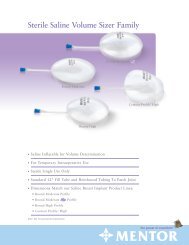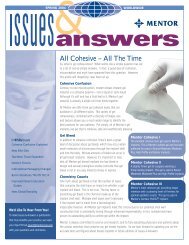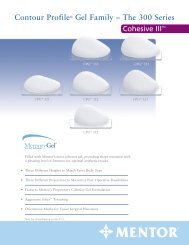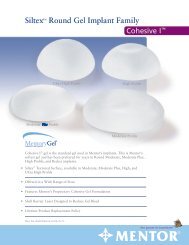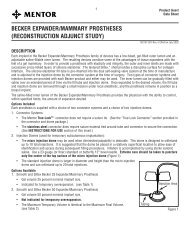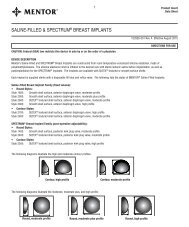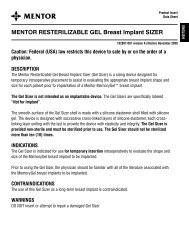Breast Reconstruction Patients Educational Brochure - Mentor
Breast Reconstruction Patients Educational Brochure - Mentor
Breast Reconstruction Patients Educational Brochure - Mentor
- No tags were found...
Create successful ePaper yourself
Turn your PDF publications into a flip-book with our unique Google optimized e-Paper software.
5Connective TissueDisease/Disorder (CTD)ContraindicationContralateralDelayed <strong>Reconstruction</strong>Delayed Wound HealingDisplacementExtracapsular RuptureExtrusionFibrocystic<strong>Breast</strong> DiseaseFibromyalgiaFibrous TissuesFlapA disease, group of diseases, or conditions affecting connectivetissue, such as muscles, ligaments, skin, etc. and/or theimmune system. Connective tissue diseases (“CTDs”) thatinvolve the immune system include autoimmune diseases suchas rheumatoid arthritis, lupus, and scleroderma.A use that is improper and should not be followed. Failureto follow contraindications identified in the labeling couldcause serious harm.The opposite side of the body.<strong>Breast</strong> reconstruction that takes place weeks, months, oryears after a mastectomy.Unusually slow progress in the healing of a wound; surgicalincision site fails to heal normally or takes longer to heal.Movement (shifting) of the implant from the usual orproper place.A type of rupture in which the silicone gel is outside of thescar capsule surrounding the breast implant (see Rupture).Skin breakdown with the implant pressing through the skinor surgical incision.Common, benign (noncancerous) changes in the tissuesof the breast. The term “disease” is misleading, and manydoctors prefer the term “change.” The condition is socommonly found in breasts, it is believed to be a variation ofnormal. Other related terms include “mammary dysplasia,”“benign breast disease,” and “diffuse cystic mastopathy.”A chronic condition characterized by widespread painin muscles and joints. It may include fatigue, difficultysleeping, and morning stiffness.Connective tissue composed mostly of fibers(for example, tendons).A portion of tissue (which may include muscle, fat, and skin),moved from one part of the body to another. The tissue flapmay or may not have its blood supply attached.





